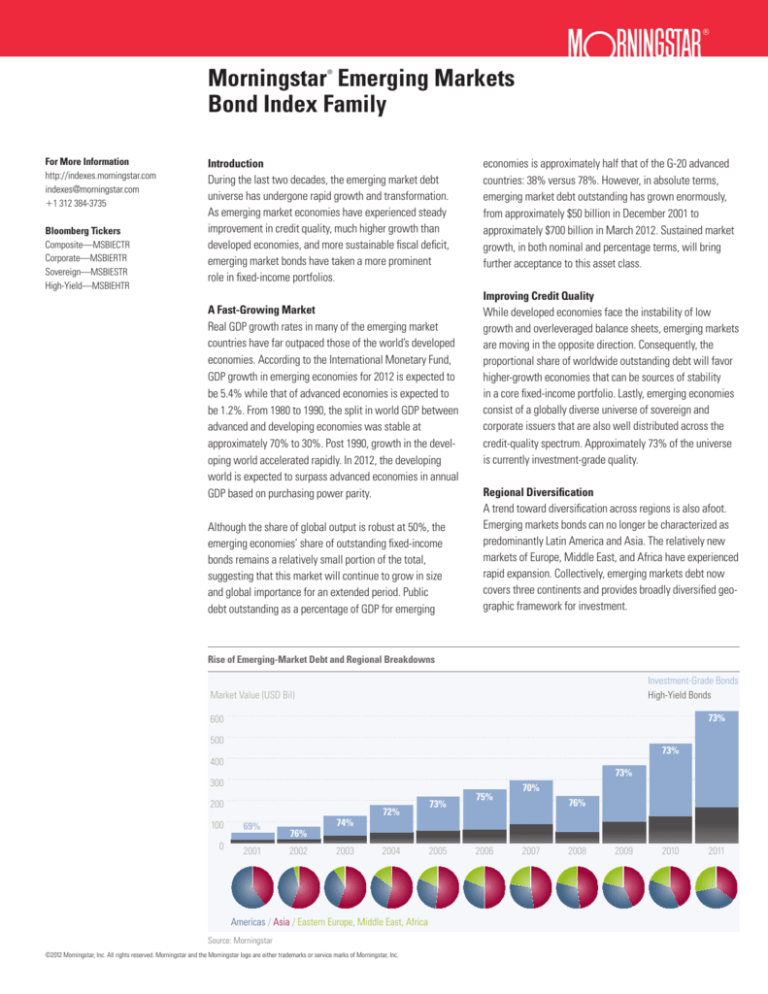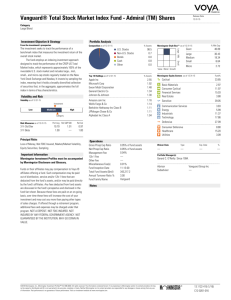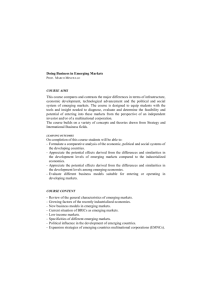
Morningstar Emerging Markets
Bond Index Family
®
For More Information
http://indexes.morningstar.com
indexes@morningstar.com
11 312 384-3735
Bloomberg Tickers
Composite—MSBIECTR
Corporate—MSBIERTR
Sovereign—MSBIESTR
High-Yield—MSBIEHTR
Introduction
During the last two decades, the emerging market debt
universe has undergone rapid growth and transformation.
As emerging market economies have experienced steady
improvement in credit quality, much higher growth than
developed economies, and more sustainable fiscal deficit,
emerging market bonds have taken a more prominent
role in fixed-income portfolios.
A Fast-Growing Market
Real GDP growth rates in many of the emerging market
countries have far outpaced those of the world’s developed
economies. According to the International Monetary Fund,
GDP growth in emerging economies for 2012 is expected to
be 5.4% while that of advanced economies is expected to
be 1.2%. From 1980 to 1990, the split in world GDP between
advanced and developing economies was stable at
approximately 70% to 30%. Post 1990, growth in the developing world accelerated rapidly. In 2012, the developing
world is expected to surpass advanced economies in annual
GDP based on purchasing power parity.
Although the share of global output is robust at 50%, the
emerging economies’ share of outstanding fixed-income
bonds remains a relatively small portion of the total,
suggesting that this market will continue to grow in size
and global importance for an extended period. Public
debt outstanding as a percentage of GDP for emerging
economies is approximately half that of the G-20 advanced
countries: 38% versus 78%. However, in absolute terms,
emerging market debt outstanding has grown enormously,
from approximately $50 billion in December 2001 to
approximately $700 billion in March 2012. Sustained market
growth, in both nominal and percentage terms, will bring
further acceptance to this asset class.
Improving Credit Quality
While developed economies face the instability of low
growth and overleveraged balance sheets, emerging markets
are moving in the opposite direction. Consequently, the
proportional share of worldwide outstanding debt will favor
higher-growth economies that can be sources of stability
in a core fixed-income portfolio. Lastly, emerging economies
consist of a globally diverse universe of sovereign and
corporate issuers that are also well distributed across the
credit-quality spectrum. Approximately 73% of the universe
is currently investment-grade quality.
Regional Diversification
A trend toward diversification across regions is also afoot.
Emerging markets bonds can no longer be characterized as
predominantly Latin America and Asia. The relatively new
markets of Europe, Middle East, and Africa have experienced
rapid expansion. Collectively, emerging markets debt now
covers three continents and provides broadly diversified geographic framework for investment.
Rise of Emerging-Market Debt and Regional Breakdowns
Investment-Grade Bonds
High-Yield Bonds
Market Value (USD Bil)
73%
600
500
73%
400
73%
300
200
100
69%
0
2001
76%
2002
74%
2003
72%
2004
Americas / Asia / Eastern Europe, Middle East, Africa
Source: Morningstar
©2012 Morningstar, Inc. All rights reserved. Morningstar and the Morningstar logo are either trademarks or service marks of Morningstar, Inc.
73%
2005
75%
2006
70%
76%
2007
2008
2009
2010
2011
Morningstar ® Emerging Markets Bond Index Family
The Morningstar Emerging Markets Bond Index Family
Morningstar®
Emerging Markets
Composite Bond
Index
Morningstar®
Emerging Markets
Sovereign Bond
Index
Composite
The Morningstar Emerging Markets Composite Bond Index
includes the most liquid sovereign and corporate
bonds issued in U.S. dollars by the governments and
corporations of emerging market countries.
Sovereign
The Morningstar Emerging Markets Sovereign Bond
Index includes the most liquid sovereign bonds
issued in U.S. dollars by the governments of emerging
market countries.
SM
SM
Morningstar®
Emerging Markets
Corporate Bond
Index
SM
Corporate
The Morningstar Emerging Markets Corporate Bond
Index includes corporate bonds issued in
U.S. dollars by corporations domiciled in emerging
market countries.
Morningstar®
Emerging Markets
Investment Grade
Bond Index
SM
Morningstar®
Emerging Markets
High Yield Bond
Index
SM
Investment Grade
The Morningstar Emerging Markets Investment Grade
Bond Index combines the Emerging Markets Sovereign
and Emerging Markets Corporate Bond Indexes,
with an additional credit rating restriction to isolate
investment-grade debt.
High Yield
The Morningstar Emerging Markets High Yield Bond Index
combines the Emerging Markets Sovereign and Emerging
Markets Corporate Bond Indexes, with an additional credit
rating restriction to isolate below-investment-grade debt.
Construction Rules for Morningstar Emerging Markets Bond Indexes
Morningstar Emerging Markets
Composite Bond Index
Morningstar Emerging Markets Sovereign Bond Index
Morningstar Emerging Markets Corporate Bond Index
Inclusion Criteria
• Fixed-rate bonds denominated in USD
• Bonds with embedded options and with sinking funds.
• Bonds must have a minimum of 36 months maturity at time
of issuance and a minimum of 13 months to maturity.
• Minimum $1 bil issuer amount outstanding.
• Minimum $500 mil issue amount outstanding.
• Includes regulation S or 144a private placement securities.
Inclusion Criteria
• Fixed-rate bonds denominated in USD
• Bonds with embedded options and with sinking funds.
• Bonds must have a minimum of 36 months maturity at time
of issuance and a minimum of 13 months to maturity.
• Minimum $1 bil issuer amount outstanding.
• Minimum $500 mil issue amount outstanding.
• Includes regulation S or 144a private placement securities.
Exclusion/Removal Criteria
• Bonds issued in local currency and subordinated debt
are excluded.
• Fixed-to-floating rate bonds are removed at the
next rebalancing.
Exclusion/Removal Criteria
• Bonds issued in local currency and subordinated debt
are excluded.
• Fixed-to-floating rate bonds are removed at the
next rebalancing.
Pricing Sources
• IDC.
Pricing Sources
• IDC.
Rules for Defaulted Securities
• Bonds are not removed if the default occurs after inclusion.
Rules for Defaulted Securities
• Corporate issuers in default are removed at the next rebalancing.
Ratings Requirements
• Sovereign bond rating is the lower of Standard & Poor’s
and Moody’s.
• At least one rating must be present for inclusion in the index.
• Issuers must be rated A+ or below.
Ratings Requirements
• At least one rating
• Corporate bond rating is the average of Standard & Poor’s, Moody’s and Fitch.
• There is no rating restriction.
Weighting Methodology
• No one country has a par amount greater than 15% of
the par amount of the overall index.
©2012 Morningstar, Inc. All rights reserved. Morningstar and the Morningstar logo are either trademarks or service marks of Morningstar, Inc.
Weighting Methodology
• No one issuer has a par amount greater than 5% of
the par amount of the overall index.









